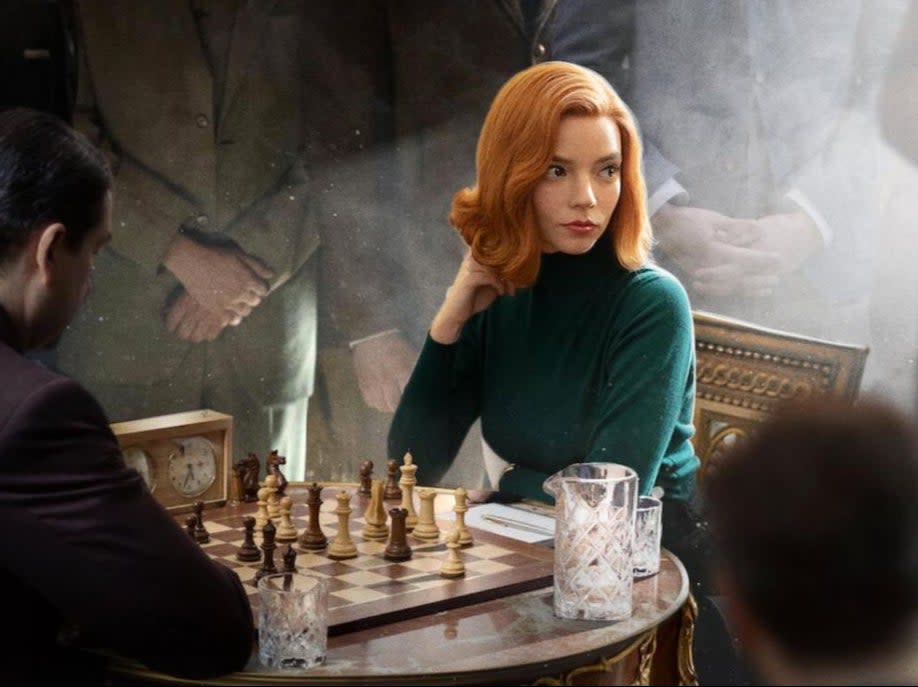Netflix’s glossy dramas get all the attention, but there’s much to be said for low-budget TV and film

Netflix drama ‘The Queen’s Gambit’
(Rex)One small consolation of lockdown is an abundance of glossy, expansively produced TV dramas to stream as and when you want them.
I know, I know, that’s a bit like me saying one small consolation of my getting run over by a truck is qualifying for a blue badge that sometimes makes parking my adapted car a bit easier, but in pandemic-land you have to find your crumbs of comfort where you can.
Netflix made a huge splash with The Queen’s Gambit, Disney’s just debuted WandaVision after wrapping up the second season of The Mandalorian, the Beeb dived into a sizeable pool of US money (HBO’s handling the overseas distribution) to help with His Dark Materials. I could go on. You could easily pick a list of your own favourites. They’re more than just crumbs if you’re able to get lost in them.
But is it possible to have too much of a good thing? To become desensitised to yet another gorgeous framing shot before being moved into a perfectly designed set for the next plot development?
ITV’s been urging BritBox on me for a while and I thought I’d dip in, having got to that stage where I thought, you know, I’ve seen almost everything I want to see (I realise there’s a vast virtual library on Netflix but that bloody algorithm just can’t be trusted to find the good stuff).
I’m not big on nostalgia but the service, which started off with offerings from ITV, the BBC and then added Channel Four too, offered a welcome change of pace. And through it I rediscovered Sapphire & Steel.
It’s curious that, in an era when the “cult” show has gone mainstream, this one never quite secured that status. A sort of ITV answer to Doctor Who, but spookier and with a much vaguer premise, it secured singularly impressive ratings when it made its debut in 1979, but after just over 30 episodes it got lost in the mists of time and left on a cliffhanger. It was swallowed up by the seemingly perpetual reorganisations the government forced on the patchwork of operators that collectively made up ITV before they were all absorbed into the single company that bears the name today.
Another point of difference from the famous Time Lord’s adventures is that the latter succeeded in spite of its budgetary limitations before the glossy relaunch we know today. I think its commercial counterpart succeeded because of them.
The first season of Sapphire & Steel is set almost entirely within the confines of a family home, the second in a dilapidated and deserted railway station and the shabby hotel attached to it, although it’s scarcely any less claustrophobic.
You get the impression that most of the money was spent on Joanna Lumley and David McCallum; the malevolent, nursery rhyme-obsessed force plaguing the victimised family in the first run is represented by lights on the floor that look like they were produced by a cheap torch.
But it doesn’t matter. Like most good spooky stories, it uses the viewer’s imagination to fill in the gaps.
A similar dynamic can be seen in some of the better low-budget horror films. The Blair Witch Project, a regular in lists of the greatest of all time, is perhaps the best example.
Its creators were similarly strapped for cash but once again, that’s arguably why it succeeded. Hollywood duly showered them in green for the sequel and it bombed so spectacularly that the emerging franchise was strangled.
Sometimes less really is more, particularly if the acting, and crucially the writing, is of sufficiently high quality. Perhaps there’s an answer there for those looking at Netflix budgets and wondering how to compete with its ability to seemingly churn out mega-budget dramas at will.
I spoke to BritBox’s programming and scheduling lead Craig Morris before writing this and he noted that they have created in line with the expectations of today’s viewers. Space ships that look as if they were put together with a couple used washing-up bottles and some glue aren’t going to cut it. And that’s a fair point.
But I think there’s a business case for putting the ingredients that made Sapphire & Steel, Blair Witch and others a success in a box and shaking them up, especially if it involves using creators from non-traditional backgrounds, who often struggle to get noticed.
Catching lightning in a bottle isn’t easy but somewhere out there someone’s working on a smash hit that makes a virtue of the fact that it's being made for 25 quid and a bottle of fizz for the woman who allowed her farm to be used as the location. If they can find a broadcaster to let them breathe, maybe they can make it rain because I sense a desire for something different from a square-eyed population that’s one step away from going stir crazy.
Read More
Huge list of secret Netflix codes unlock hidden films and TV shows
Wes Craven dead: The king of low-budget horror films was once a
The Blair Witch Project TV series in the works
Former Dr Who star Colin Baker hails Jodie Whittaker casting

